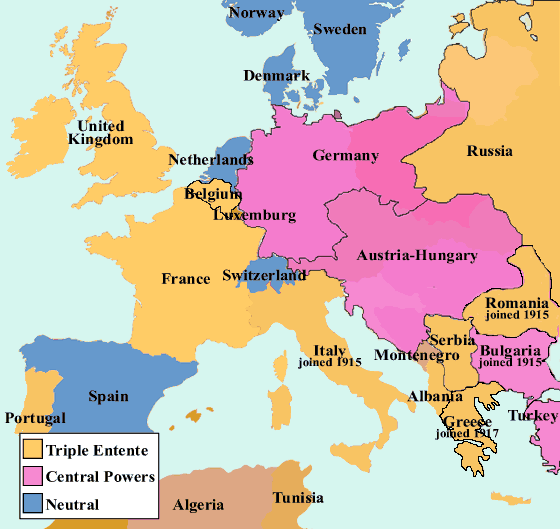

"Dan-Joe & Malcolm (WW1)" -- TOC
Introduction

At the beginning of World War One, in 1914, it is to be remembered, that the modern world was only just creeping in. Twenty years had passed since Chicago's "World's Fair" when there was a successful demonstration of the use of electricity for illumination and power. In 1896, the British parliament repealed the Red Flag Act, an act which required the operator of a mechanized contraption used on a public road to be proceeded with a man carrying a red flag to warn unsuspecting pedestrians. In 1903, Orville and Wilbur Wright made the first flight in a heavier-than-air machine at Kitty Hawk, North Carolina. In 1906, the International Radiotelegraph Union was formed so to allot separate wavelengths for the new invention of the wireless. In 1909, Henry Ford introduced the first popular automobile, the "Model T," which was produced by assembly-line methods.
We will, in the coming chapters, give a rundown of events leading up to the First World War. At the beginning of it, for a brief time, the western nations of the world thought that it was a "local disagreement" which would blow over; but, it did not; and nation after nation tumbled into the great abyss of World War One. It lasted four years and took the lives of millions.
While we will explore a number of questions when considering the beginnings of the "Great War," its conduct and conclusion; this work is essentially concerned with the Canadian involvement in World War One, or more particularly on how this war dealt a dreadful blow to so many families. As we can determine from their official war records, my two maternal uncles were in the thick of it. We make it an interlacing theme, as we follow along these two young men from Glace Bay, a small town in Nova Scotia, to the battlefields of northern France. Though the war officially got a start in August of 1914, we pick up the details beginning in March of 1916. This was when our two heroes, Dan-Joe and Malcolm Morrison, arrived at France to fight for the Allies. In the course of things, we will give, in an abbreviated manner, an overall account of the major battles.
We begin things, by a quote, which should give an overall picture:
"In 1914 Canada had just over 3,000 regular soldiers. Based at harbour fortifications, the Canadian Army was backed up by a militia of local volunteers. Expecting a war in Europe during the summer of 1914 the Canadian government asked for volunteers to join a Canadian Expeditionary Force (CEF).
Over 30,000 Canadian soldiers reached Britain for training at Salisbury Plain in October. Lieutenant-General William Anderson and the 1st Canadian Division arrived on the Western Front in February 1915 and immediately saw action at Ypres. Over the next two weeks the Canadians suffered 5,500 casualties. ...
Men in Canada were enthusiastic volunteers and by 1916 two more divisions had been sent to France. Commanded by the General Julian Byng, the Canadian Corps successfully took the strategically important Vimy Ridge in April 1917. Byng was replaced by the Canadian officer, General Arthur Currie in June 1917 and he led the Canadians through the Amiens Offensive, the Canal du Nord and the other victories on the Western Front during the later stages of the war.
Almost 600,000 Canadians joined the army during the First World War. Of these, 418,000 served overseas with the Canadian Expeditionary Force (CEF) ... The CEF had 210,000 casualties, of whom, 56,500 were killed."1
Or, GO TO
TABLE OF CONTENTS
Peter Landry
2015